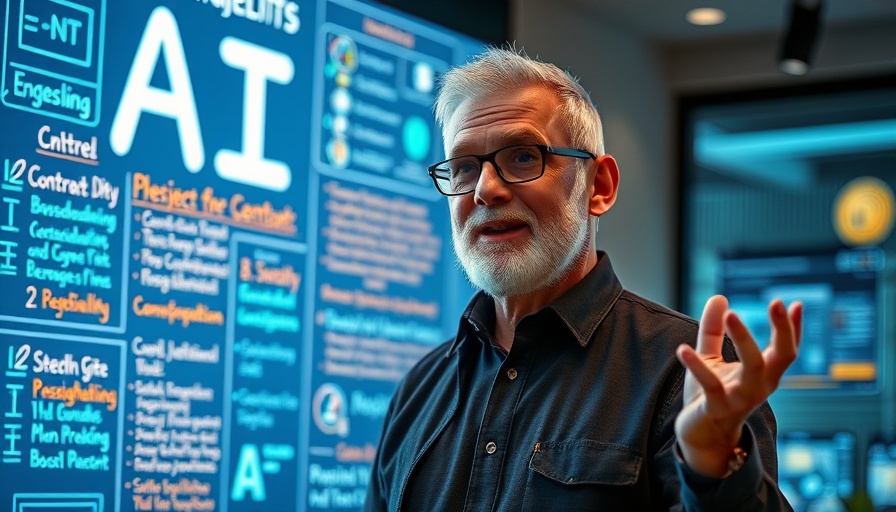
Understanding the Distinction: AI Learning vs. Human Learning
Artificial Intelligence (AI) systems, particularly Large Language Models (LLMs), have made significant strides in mimicking human intelligence. However, one of the most critical differences lies in how humans and LLMs learn. Human learning is characterized by neuroplasticity—the brain's ability to adapt its neural networks in response to experience.
In 'AI vs Human Thinking: How Large Language Models Really Work', the discussion dives into the intricate comparisons between human cognition and AI processes, prompting a deeper analysis relevant to business and education in Africa.
This allows individuals to form lasting memories with minimal exposure. In contrast, LLMs learn through backpropagation, a process requiring vast amounts of training data and numerous adjustments to their internal weights. While humans may learn a new concept from a single instance, AI requires extensive repetition. The implications of such a difference are profound, particularly for educational and training applications across Africa, where efficient learning methods can significantly influence future skill development.
The Complexity of Information Processing: A Key Differentiator
When it comes to information processing, human brains work in a highly parallel and distributed manner, utilizing billions of neurons to process concepts rather than mere tokens. This content addressable method enables humans to connect new information with prior knowledge seamlessly. On the other hand, LLMs operate through a sequence of tokens—essentially predicting the next word in a sentence based on patterns derived from their extensive training data. This distinction raises critical questions about the future of education and content creation in African communities, as we explore how to integrate AI tools effectively without compromising the nuanced understanding that human thought provides.
Memory: How it Shapes Learning and Creativity
Memory plays a pivotal role in shaping both human creativity and the capabilities of LLMs. Humans possess a multifaceted memory system, featuring sensory memory, working memory, and long-term memory, all of which allow for associative learning influenced by context and emotion. In stark contrast, LLMs have a much simpler architecture—information is stored within model weights, while the model's context window limits its capability to retain information. This difference is significant, as it signals potential limitations for LLMs in generating contextually relevant content, which could be addressed through well-structured AI policy and governance frameworks that ensure these technologies support African businesses and educational needs effectively.
Reasoning: Understanding the Differences in Thought Processes
Reasoning represents another essential component where human thinking diverges from AI functionality. Humans engage in two modes of reasoning—System 1, characterized by intuition, and System 2, characterized by deliberate thought processes. LLMs have been primarily trained on outputs of System 2, allowing them to present logically coherent responses. Nevertheless, AI does not genuinely understand reasoning in the human sense; it generates plausible sequences based on existing patterns. As such, health and education sectors in Africa must be cautious in implementing AI for decision-making processes, ensuring these tools complement human intellect rather than replace it.
Addressing Hallucinations and Human Confabulation
A significant challenge of LLMs is their propensity for 'hallucination.' This term describes instances where AI produces inaccurate information confidently. The human equivalent, termed confabulation, occurs when individuals unknowingly create false memories or explanations. This cognitive nuance is critical when deploying AI in contexts that require accuracy and reliability. Recognizing such risks can help policymakers structure AI regulations that foster accountability and trust in educational tools and business applications using AI technology.
The Role of Embodiment in Cognitive Processing
Arguably, one of the most fundamental differences between AI and human cognition lies in embodiment. Humans, with their tangible sensory experiences, learn from real-world interactions, shaping their understanding of concepts through lived experiences. In contrast, LLMs exist in a disembodied virtual realm, acquiring knowledge solely from texts. This disconnection often leads to a lack of common sense knowledge in AI responses. As the African continent navigates the integration of AI in various sectors, fostering an understanding of embodiment could enhance AI's application in contexts where human-like understanding is paramount.
The Future of AI in Africa: A Harmonious Coexistence
While AI models and human minds can generate outputs that look remarkably similar—like essays or answers—their cognitive processes remain fundamentally different. To leverage AI effectively, especially in African development, a nuanced understanding of these differences is essential. Striving for synergy between AI's vast knowledge base and human intelligence's binary comprehension may yield innovative strategies for education, entrepreneurship, and governance.
The path forward for African businesses and educational institutions hinges not only on implementing AI solutions but also on crafting thoughtful AI policy and governance that understands both the potential and limitations of this technology. Adopting these insights can empower communities to harness AI's strengths while ensuring that the human element—creativity, intuition, and ethical reasoning—remains at the forefront of technological advancement.
 Add Row
Add Row  Add
Add 




Write A Comment